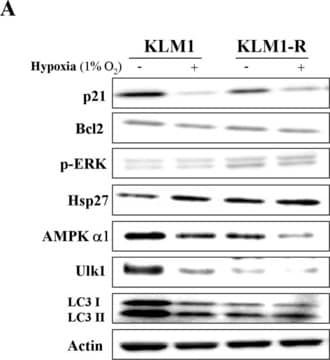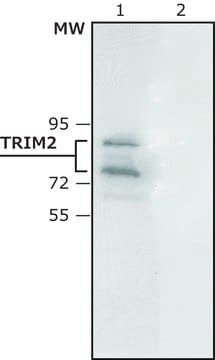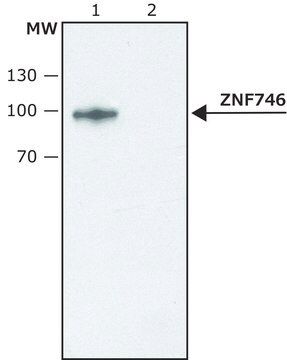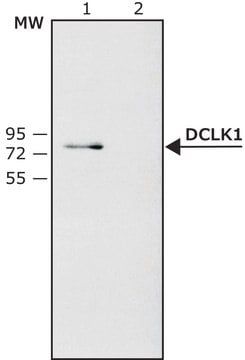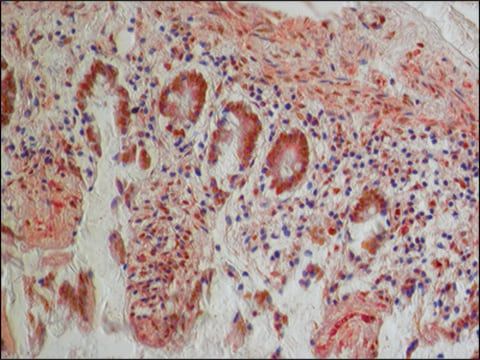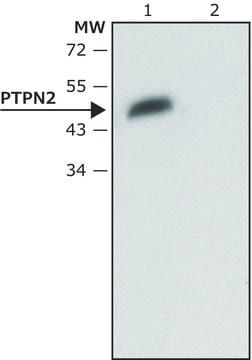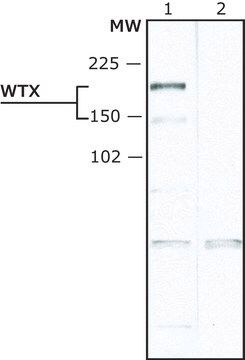SAB4200184
Anti-WTX (N-terminal) antibody produced in rabbit
~1.0 mg/mL, affinity isolated antibody
Manufacturer: Sigma Aldrich
Synonym(S): Anti-AMER1, Anti-FAM123B, Anti-FLJ39827, Anti-OSCS, Anti-Wilms tumor gene on the X chromosome
Select a Size
| Pack Size | SKU | Availability | Price |
|---|---|---|---|
| 200 μL | SAB4200184-200-μL | In Stock | ₹ 51,248.70 |
SAB4200184 - 200 μL
In Stock
Quantity
1
Base Price: ₹ 51,248.70
GST (18%): ₹ 9,224.766
Total Price: ₹ 60,473.466
biological source
rabbit
conjugate
unconjugated
antibody form
affinity isolated antibody
antibody product type
primary antibodies
clone
polyclonal
form
buffered aqueous solution
mol wt
antigen ~190 kDa
species reactivity
human
enhanced validation
recombinant expressionLearn more about Antibody Enhanced Validation
concentration
~1.0 mg/mL
Description
- General description: APC membrane recruitment protein 1 (AMER1) or Wilms Tumor on the X (WTX) gene, also known as FAM123B, comprises adenomatous polyposis coli (APC) interacting domains, nuclear localization signal (NLS), phospholipid binding region, six conserved block sequences and β-catenin binding region. The N-terminal region harbors the internal splicing sites (donor and acceptor). It encodes three isoforms AMER1, AMER2 and AMER3 APC, by alternative splicing at the N-terminus. WTX gene is localized on the X chromosome. The phosphatidylinositol (4,5)-bisphosphate binding site of the WTX aids its localization to the plasma membrane.
- Specificity: Anti-WTX (N-terminal) specifically recognizes human WTX.
- Application: Anti-WTX (N-terminal) antibody produced in rabbit has been used in chromatin immunoprecipitation[1] and immunoblotting.
- Biochem/physiol Actions: APC membrane recruitment protein 1 (AMER1) or WTX is localized in the subnuclear compartment and participates in RNA processing, transcription and cell differentiation. In cultured cells, WTX negatively regulates the WNT/β-catenin signaling by promoting β-catenin ubiquitination and thus targets its degradation by the proteasome. WTX has been shown to form a complex with β-catenin, Axis inhibition protein 1 (AXIN1), β-transducin repeat containing protein 2 (β-TrCP2) and adenomatous polyposis coli (APC). WTX mutations are majorly somatic and the gene deletions and truncations is implicated in 30% of Wilms tumors. The mutations were confined to the active X and single X chromosomes in females and males respectively.. Loss of WTX function in Wilms tumor results in stabilization of β-catenin and its translocation to the nucleus. WTX co-localizes with non-POU domain-containing octamer-binding protein (p54nrb/NONO) and binds Wilms′ tumor protein 1 (WT1) to modulate its activity, suggesting that WTX may play a role in the transcriptional regulation.
- Physical form: Solution in 0.01 M phosphate buffered saline, pH 7.4, containing 15 mM sodium azide.
- Storage and Stability: For continuous use, store at 2–8 °C for up to one month. For extended storage, freeze in working aliquots. Repeated freezing and thawing, or storage in “frost-free” freezers, is not recommended. If slight turbidity occurs upon prolonged storage, clarify the solution by centrifugation before use. Working dilutions should be discarded if not used within 12 hours.
- Disclaimer: Unless otherwise stated in our catalog or other company documentation accompanying the product(s), our products are intended for research use only and are not to be used for any other purpose, which includes but is not limited to, unauthorized commercial uses, in vitro diagnostic uses, ex vivo or in vivo therapeutic uses or any type of consumption or application to humans or animals.
SAFETY INFORMATION
Flash Point(F)
Not applicable
Flash Point(C)
Not applicable
Compare Similar Items
Show Difference
biological source: rabbit
conjugate: unconjugated
antibody form: affinity isolated antibody
antibody product type: primary antibodies
clone: polyclonal
form: buffered aqueous solution
mol wt: antigen ~190 kDa
species reactivity: human
enhanced validation: recombinant expressionLearn more about Antibody Enhanced Validation
concentration: ~1.0 mg/mL
biological source:
rabbit
conjugate:
unconjugated
antibody form:
affinity isolated antibody
antibody product type:
primary antibodies
clone:
polyclonal
form:
buffered aqueous solution
mol wt:
antigen ~190 kDa
species reactivity:
human
enhanced validation:
recombinant expressionLearn more about Antibody Enhanced Validation
concentration:
~1.0 mg/mL
biological source: rabbit
conjugate: unconjugated
antibody form: affinity isolated antibody
antibody product type: primary antibodies
clone: polyclonal
form: buffered aqueous solution
mol wt: antigen ~52 kDa
species reactivity: human
enhanced validation: recombinant expressionLearn more about Antibody Enhanced Validation
concentration: ~1.5 mg/mL
biological source:
rabbit
conjugate:
unconjugated
antibody form:
affinity isolated antibody
antibody product type:
primary antibodies
clone:
polyclonal
form:
buffered aqueous solution
mol wt:
antigen ~52 kDa
species reactivity:
human
enhanced validation:
recombinant expressionLearn more about Antibody Enhanced Validation
concentration:
~1.5 mg/mL
biological source: rabbit
conjugate: unconjugated
antibody form: affinity isolated antibody
antibody product type: primary antibodies
clone: polyclonal
form: buffered aqueous solution
mol wt: ~81 kDa
species reactivity: rat, mouse, human
enhanced validation: recombinant expressionLearn more about Antibody Enhanced Validation
concentration: ~1.5 mg/mL
biological source:
rabbit
conjugate:
unconjugated
antibody form:
affinity isolated antibody
antibody product type:
primary antibodies
clone:
polyclonal
form:
buffered aqueous solution
mol wt:
~81 kDa
species reactivity:
rat, mouse, human
enhanced validation:
recombinant expressionLearn more about Antibody Enhanced Validation
concentration:
~1.5 mg/mL
biological source: rat
conjugate: unconjugated
antibody form: purified from hybridoma cell culture
antibody product type: primary antibodies
clone: Clone 6F10, monoclonal
form: buffered aqueous solution
mol wt: ~21 kDa
species reactivity: mouse, monkey, canine, rat, human
enhanced validation: __
concentration: ~1.0 mg/mL
biological source:
rat
conjugate:
unconjugated
antibody form:
purified from hybridoma cell culture
antibody product type:
primary antibodies
clone:
Clone 6F10, monoclonal
form:
buffered aqueous solution
mol wt:
~21 kDa
species reactivity:
mouse, monkey, canine, rat, human
enhanced validation:
__
concentration:
~1.0 mg/mL

